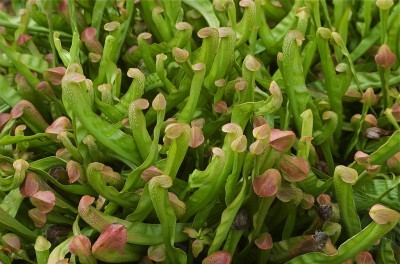






Pitcher plant care is relatively easy and they make interesting houseplants or outdoor specimens in milder climes. Do pitcher plants need fertilizer? In ideal conditions, the plant makes all the food it needs by supplementing with insects that provide nitrogen. Indoor plants may need a little help in the nitrogen department. Find out how to fertilize a pitcher plant and enjoy the distinctive appearance and habits of this amazing species.
Sarracenia is a large group of carnivorous plants found across the globe. More commonly known as pitcher plant, the genus is formed of plants that have found a unique way to survive in low nutrient soil. Sarracenia are North American natives. Nepenthes are the tropical varieties of pitcher plant, which need warm weather and plenty of humidity.
The plants harvest insects by trapping them in their pitcher-shaped leaves. The insects provide nitrogen for the plant’s growth and health. In the wild they thrive without anyone feeding, but potbound plants will benefit from additional nutritional supplementation. Seedlings also need some food in addition to their soil medium since they do not have properly formed pitchers in which to catch gnats and other tiny insects.
Use any porous potting mix, such as orchid mix, for growing pitcher plants. It should be slightly acidic and well draining. Plant pitcher plants in an unglazed ceramic pot with good drainage holes.
Both groups of the plant require plenty of water and should never be allowed to dry out. They love to be in a dish of water or even at the edge of a water garden. An important part of pitcher plant care is the type of water. These plants are sensitive to tap water and should be in contact with distilled or rain water only.
Full sun locations are preferable with some shelter from the harshest midday rays. Outdoor plants have plenty of opportunity to catch flies while indoor plants may need you to hunt for them. Without supplemental insects, fertilizing pitcher plants is necessary to keep them healthy.
Pitcher plants should not be fertilized over the soil. The plants are used to low nutrient soil in their native habitats and excess nutrients can actually kill them. Instead, if the plant is doing poorly, try to feed it an insect via the pitcher structures or add diluted liquid fertilizer directly into the tubular leaves.
A high nitrogen pitcher plant fertilizer is perfect to fulfill the plant’s needs. A mild fish fertilizer diluted by one-quarter every two to four weeks can be added to the pitcher.
Young plants and seedlings benefit more from fertilizer and may be soil fed. Dilute by half and follow any soil feeding with a drench of rainwater or distilled water. Make sure the pitcher is at least half full before fertilizing pitcher plants.
Outdoor plants should be fine without extra feeding, provided they are in a moist, acidic soil and bright light. Some commercial formulas that work well as pitcher plant fertilizer are Osmocote, Miracid and Miracle Grow. Don’t forget to dilute the fertilizer heavily with mineral free water.
Copyright © www.100flowers.win Botanic Garden All Rights Reserved